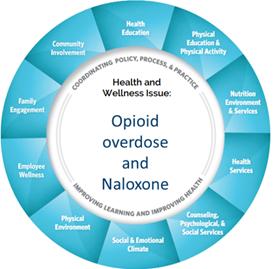School Health Services
- School Health Services Home
- School Nurse Workforce: A 2022 Snapshot
- Developing a School Health Program
- Infection Prevention and Control
- Managing Seizures in School
- Medication Administration Guide
- Naloxone Administration in School Settings
- Prevention, Promotion and Protection
- School Health Essentials
- School Nursing Practice
- School-Based Health Centers in MN
Related MDH Programs
Naloxone Administration in School Settings
Go to: School Toolkit
Two Legislative Changes Effective 7/1/2023
First Legislative Change
- A school district or charter school must maintain a supply of opiate antagonists, as defined in section 604A.04, subdivision 1, at each school site to be administered in compliance with section 151.37, subdivision 12.
- Each school building must have two doses of nasal naloxone available on-site.
- The commissioner of health shall identify resources, including at least one training video to help schools implement an opiate antagonist emergency response and make the resources available for schools.
- A school board may adopt a model plan for use, storage, and administration of opiate antagonists.
Second Legislative Change
The language change allows all nurses and school personnel to administer naloxone in a school setting.
Minnesota Statute 151.37 Subd. 12. Administration of opiate antagonists for drug overdose.
The toolkit was developed to assist Schools and School Districts across Minnesota with guidance and recommendations to put into place an emergency response to the public health crisis related to rising youth and adult opioid overdoses which are life threatening.
Naloxone (i.e., Narcan) is an opioid antagonist that will temporarily reverse deadly respiratory depression experienced by an opioid overdose. When administered quickly and effectively, naloxone can immediately restore breathing to a victim experiencing an opioid overdose and prevent death.
The Whole School, Whole Community, Whole Child, or WSCC model, is CDC’s framework for addressing health in schools. The WSCC model is student-centered and emphasizes the role of the community in supporting the school, the connections between health and academic achievement and the importance of evidence-based school policies and practices. CDC: Whole School, Whole Community, Whole Child (WSCC). The WSCC model has 10 components:

- Physical education and physical activity
- Nutrition environment and services
- Health Education
- Physical environment
- Social and Emotional climate
- Health Services
- Counseling, psychological, and social services
- Employee wellness
- Community involvement
- Family Engagement
While the guidance and recommendations will focus on the Health Services component, consideration should be given to strategies in other components including prevention, education, communication, community, and supports for students and staff, to ensure a comprehensive approach.
These web pages include guidance, recommendations, and resources to develop and create an emergency response to overdose including the administration of naloxone.
The School Toolkit includes information and recommendations for school policy and emergency procedure development, role of medical provider for standing orders/protocols and prescription, resources for obtaining naloxone medication, resources for education and training, and recovery / referral resources to meet the needs of those are at risk or who have experienced an overdose.